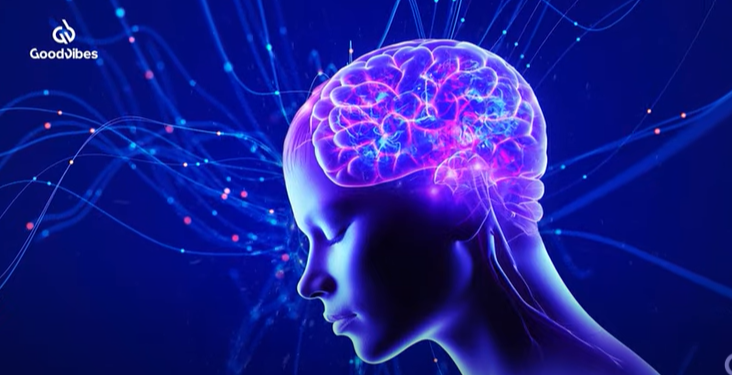Binaural Beats For Mental Health – Out Of Body Phenomenon
Binaural beats are a fascinating audio phenomenon designed to influence your brain. Imagine two slightly different frequencies presented separately, one to each ear. For many, binaural beats for mental health works. 
Binaural Beats for Mental Health
The main reason why binaural beats for mental health works is because of one thing. Your brain, the clever organ it is, processes this disparity as a beat frequency, However, this doesn’t exist in the physical world. This is the binaural beat.
What is Binaural Beats ?
It’s fairly simple. You listen through headphones. One ear gets a specific frequency, and the other ear gets a slightly different one. Your brain fills in the gap, producing a third tone that some people believe affects your mental state. They were first discovered by a physicist.
Who Created Binaural Beats?
The origin of binaural beats dates back to more than a century ago. Heinrich Wilhelm Dove, a physicist, first discovered them in 1839. Since then, they’ve piqued the interest of everyone from scientists to wellness enthusiasts.
Despite their age, they’ve gained popularity in recent years as a tool for relaxation and mental clarity. These beats have different frequencies.
Binaural Beats Have Different Frequencies
Different frequencies in binaural beats supposedly bring out various effects. Frequencies are generally grouped into four categories – delta, theta, alpha, and beta.
Delta, Theta, Alpha and Beta Waves
Delta waves (1-4 Hz) are associated with deep sleep and healing. Theta (4-8 Hz) can promote meditation and creativity. Alpha (8-14 Hz) is linked to relaxation, while beta waves (14-30 Hz) might boost alertness and concentration. Let’s dive in to see if they hold up to science. 
Does Binaural Beats hold up Scientifically?
While there’s lots of anecdotal evidence promoting their benefits, the scientific community remains divided. Some studies show promising results, like reduced anxiety and improved focus. Yet, other researchers urge caution, suggesting that more in-depth study is needed. To many first-time users they off a new exoerience.
Binaural Beats Offers a Unique Experience
Understanding binaural beats is the first step in deciding if they’re right for you. They’re an exciting blend of science and holistic wellness that holds potential for many. Whether you’re looking to relax, focus better, or just try something new, binaural beats offer a unique avenue to explore. They are often used in mantal health practices.
The Science Behind Binaural Beats and Mental Health
Binaural beats have a fascinating effect on brainwave patterns. When different frequencies are fed into each ear, your brain picks up the difference and creates a third, perceived frequency. The binaural beats affect your brainwaves.
Binaural Beats and Brainwave Entrainment
This interaction encourages your brainwaves to synchronize with the beat, a phenomenon known as brainwave entrainment.
Can Binaural Frequencies Influence Brain Functionality?
Several research studies explore how binaural beats might benefit mental health. Some studies indicate that sound frequencies influence brain function and emotional well-being. It also has other benefits as well.
Do Binaural Beats Reduce Anxiety and Depression?
For instance, listening to specific frequencies has been linked to reduced anxiety levels and decreased symptoms of depression. While the scientific community is still exploring these claims, early results are encouraging. It has a calming aspect as it reduces stress.
Can Binaural Beats Reduce Stress?
Binaural beats might also play a role in stress reduction. Stress is often linked to overactive beta brainwaves. By using binaural beats, you might be able to encourage your brain to shift into a more relaxed state. 
This state is marked by alpha or theta waves. Many people use binaural beat frequencies as part of their stress management toolkit. It also affects your brain’s neural pathways.
Binaural Beats Supports Neuroplasticity
The concept of neuroplasticity is also relevant here. Neuroplasticity is the brain’s ability to reorganize itself by forming new neural connections throughout life. There’s a belief that binaural beats might support this process, making your brain more adaptable and resilient.
This would be particularly beneficial for individuals dealing with mental health challenges. However, one must proceed with caution until firther research is done.
Binaural Beats Needs More Research
While there’s a lot of excitement around binaural beats, it’s essential to approach with a balanced view. Some studies show promising results, but more research is needed to fully understand the long-term effects and benefits. However, incorporating it into mental health practices could be a good thing.
Intergrating Binaural Beats with Therapy
Even so, integrating binaural beats into mental health practices has potential and is worth exploring. Always consider consulting a healthcare professional when incorporating new tools into your mental health regimen. Also, learn its practical applications in other modalities.
Practical Applications of Binaural Beats
Binaural beats find their sweet spot in meditation and mindfulness practices. The rhythmic pulsations help soothe your mind. This makes it easier to enter a meditative state.
Binaural Beats in Mindfulness Beats
Plenty of mindfulness apps incorporate binaural beats for this exact reason. Whether you are a novice or an experienced meditator, these beats will deepen your practice and help you achieve a more focused, calm state.
Binaural Beats in CBT
Cognitive-behavioral therapy (CBT) is another area where binaural beats is helpful. Therapists sometimes use them to assist clients in managing stress, anxiety, and other mental health conditions. 
By combining binaural beats with traditional CBT techniques, some people experience a more profound therapeutic impact. It’s like an extra tool in the toolkit, enhancing the overall treatment process. It is also integrated in wellness programs.
Binaural Beats Integrated in Wellness Routines
There are real-world cases where people have successfully integrated binaural beats into their wellness routines. Take, for instance, individuals dealing with chronic stress or insomnia.
Binaural Beats Paired with Other Modalities
Binaural beats may also be paired with other wellness modalities. Consider combining them with practices like yoga, massage therapy, or even during a quiet walk.
When integrated thoughtfully, binaural beats enhance these experiences, making them more relaxing or invigorating. It may also improve sleep.
Binaural Beats Improves Sleep
Some have reported significant improvements in sleep quality and stress reduction after regular sessions with binaural beats. While personal stories aren’t scientific proof, they do highlight potential benefits. Moreover, you can create your own binaural beat tracks.
Create Your Own Binaural Beat Tracks
If you’re a DIY type of person, there are plenty of resources to create your own binaural beat tracks. Free software and online platforms allow you to tailor frequencies to your specific needs. Just be sure to follow the Guidelines.
Binaural Beats Guidelines
When starting, it’s good to follow some guidelines: use quality headphones, choose the right environment, and start with short, consistent sessions. And if creating your own isn’t your style, numerous apps and platforms offer pre-made tracks to get you started. Be sure to choose the right frequency. 
Choosing the Right Binaural Beat Frequency
Navigating the different frequency ranges may initially seem overwhelming. But it’s pretty straightforward once you break it down. Different frequencies are believed to target various aspects of mental health and wellness. Here’s the breakdown:
- Delta waves (1-4 Hz) are associated with deep, restorative sleep and healing.
- Theta waves (4-8 Hz) are often linked to meditation and creativity.
- Alpha waves (8-14 Hz) help with relaxation and stress reduction.
- Beta waves (14-30 Hz) are thought to enhance alertness and cognitive function.
Understand Your Specific Needs
Selecting the right frequency involves understanding your specific needs. If you’re aiming for better sleep, delta waves are your go-to. On the other hand, if you need help focusing, beta waves might be more effective. It’s all about matching the frequency to your desired outcome.
Tools and Technologies for Binaural Beats
Several tools and technologies will help you dive into binaural beat therapy. From dedicated binaural beat apps to high-quality headphones, investing in some gear makes your experience more enjoyable.
Many apps come with different frequency presets, so you don’t have to worry about fine-tuning them yourself. Just pick what suits you best and let the app do the work.
Evaluate Binaural Beat
Evaluating commercial binaural beat products is also crucial. Not all binaural beat tracks are created equal. Look for products with good user reviews and those created by reputable producers.
These usually ensure the tracks are designed effectively and safely. Also, user feedback is a goldmine of information, so don’t skip reading through reviews before making a purchase. However, if you are a beginner, take it easy.
Start Binaural Beats Slow
For beginners, start slow. It’s easy to get excited and want to jump right in, but it’s important to let your brain adjust to the new stimuli. Begin with shorter sessions, maybe 5-10 minutes, and gradually increase the time as you become more comfortable. Consistency is essential. 
Making binaural beats part of your daily routine can help you achieve the best results over time. Most importantly, be safe and adhere to ethical issues.
Safety, Ethical Considerations, and Future Directions
While binaural beats offer promising benefits, it’s essential to be aware of potential side effects. Some users report headaches or dizziness, especially if the volume is too high. So, start with Lower Volumes.
Start Binaural Beats with Lower Volumes
Always start with lower volumes and gradually increase if needed. If you have a mental health condition, consult a healthcare professional before integrating binaural beats into your routine. Also, consider vulnerable populations.
Be Mindful of Ethical Considerations
There are ethical considerations when using binaural beats, particularly regarding vulnerable populations. Children, for instance, might not benefit in the same way adults do, and there’s still limited research on how binaural beats affect them.
Being mindful of the ethical implications ensures a responsible approach to using this technology. Also, be sure to acquire tracks by accredited creators for safety reasons.
Stick to Trusted Sources
Industry standards and regulation are still catching up with the popularity of binaural beats. Because of this, not all products are created equally. Stick to trusted sources and look for tracks made by accredited creators or backed by scientific research.
This minimizes risks and ensures a positive experience. However, more research is needed, for sure. 
Further Research is Needed
Looking to the future, there’s a lot of potential for further research and development in the field. Scientists continue to study how binaural beats impact the brain, paving the way for more targeted therapies and applications. Integration in virtual reality is on the rise.
Binaural Beats Merges with Virtual Reality
Emerging trends include integration with virtual reality (VR) and personalized algorithm-generated tracks, promising even more tailored experiences.
Final Thoughts
Binaural Beats Therapy and Mental Wellness in the Future
Experts in the field are cautiously optimistic about the future of binaural beat therapy. While more rigorous studies are needed to fully understand the long-term effects, the existing body of evidence suggests a valuable tool for mental health and wellness. The key is staying informed and using binaural beats as part of a balanced approach to mental well-being.
Founder & CEO
(w) mybluegenes.com
(e)rachele@mybluegenes.com






